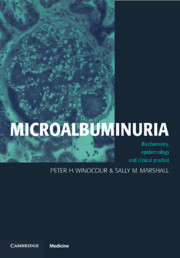Book contents
- Frontmatter
- Contents
- Preface
- Foreword by Professor K. G. M. M. Alberti
- 1 Renal structure and physiology
- 2 Measurement and expression of microalbuminuria
- 3 Epidemiology and determinants of microalbuminuria in health
- 4 Microalbuminuria in diabetes mellitus
- 5 Microalbuminuria as a marker of endothelial dysfunction
- 6 Microalbuminuria, cardiovascular risk factors and cardiovascular disease
- 7 Microalbuminuria as a non-specific marker of disease
- 8 The management of microalbuminuria in diabetes mellitus and essential hypertension
- Index
3 - Epidemiology and determinants of microalbuminuria in health
Published online by Cambridge University Press: 06 July 2010
- Frontmatter
- Contents
- Preface
- Foreword by Professor K. G. M. M. Alberti
- 1 Renal structure and physiology
- 2 Measurement and expression of microalbuminuria
- 3 Epidemiology and determinants of microalbuminuria in health
- 4 Microalbuminuria in diabetes mellitus
- 5 Microalbuminuria as a marker of endothelial dysfunction
- 6 Microalbuminuria, cardiovascular risk factors and cardiovascular disease
- 7 Microalbuminuria as a non-specific marker of disease
- 8 The management of microalbuminuria in diabetes mellitus and essential hypertension
- Index
Summary
The definition of microalbuminuria
The epidemiology of microalbuminuria is not straightforward. At present, large studies are few and far between, there is no standardisation of sample collection conditions and the expression of microalbuminuria, and the precise definition of ‘normality’ is not yet established. Whereas it may be acceptable in standard laboratory practice to produce a clinically useful reference range, this is not the case for microalbuminuria. A more appropriate approach is to examine the distribution of microalbuminuria in a representative community sample which is not subject to selection bias. Whilst there are several early reports of microalbuminuria in ostensibly healthy populations, only the Copenhagen City Heart Study has carefully defined their study population as a true random sample of a well defined population denominator. Even then it may not necessarily be correct to define ‘abnormality’ in these studies as values outside the 95th percentile. A useful parallel is blood pressure and lipid distribution, where even carefully defined population-based ranges may be misleading. The importance of all these three parameters is not necessarily the absolute distribution of the data, but the attributable risk for a clinical end point at various levels. Present clinical practice has taken account of this in assessment of blood pressure and lipids, and it is now necessary to consider the impact of age, gender and ethnic origin on expression of abnormality, which in turn is based upon prospective studies which have defined the relative and absolute risk of various end points.
- Type
- Chapter
- Information
- MicroalbuminuriaBiochemistry, Epidemiology and Clinical Practice, pp. 40 - 52Publisher: Cambridge University PressPrint publication year: 1998



